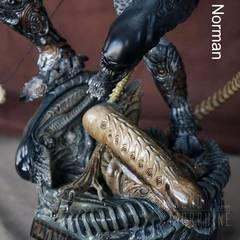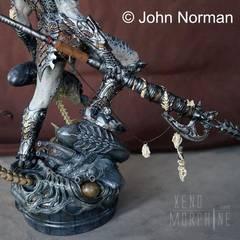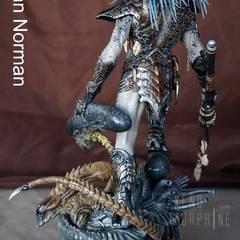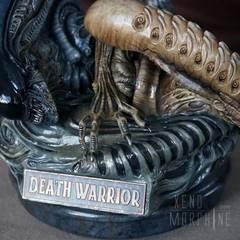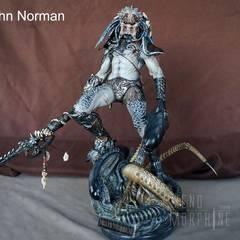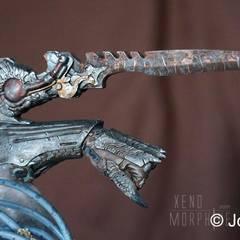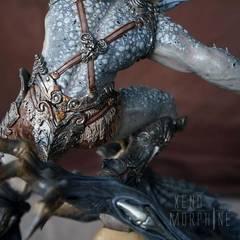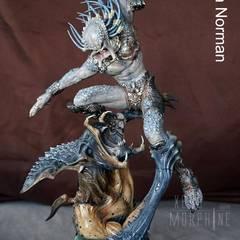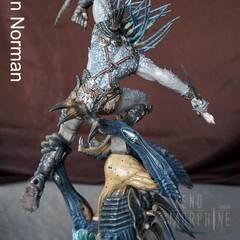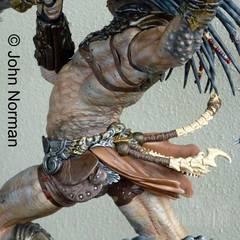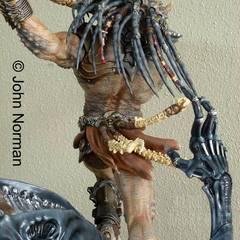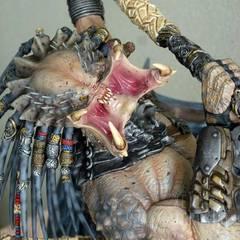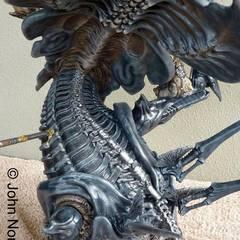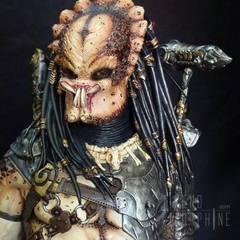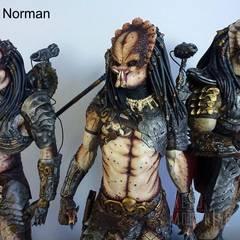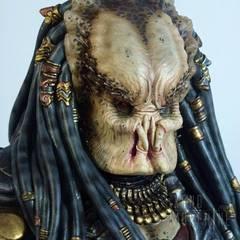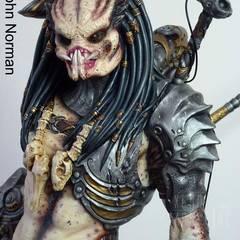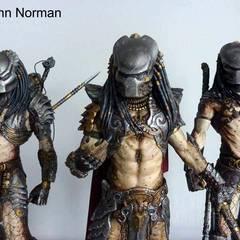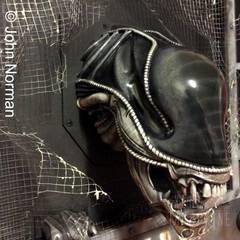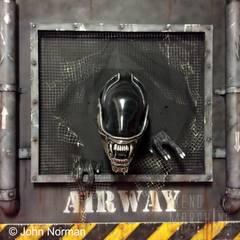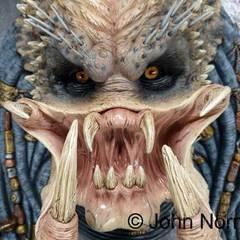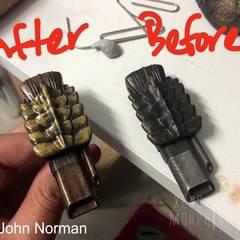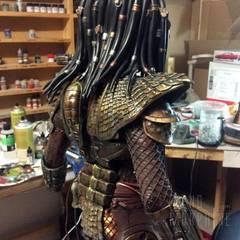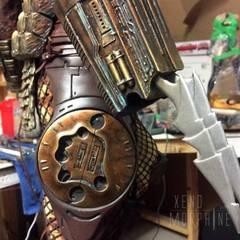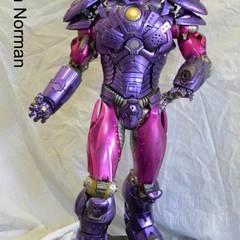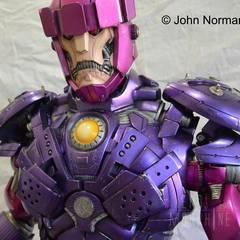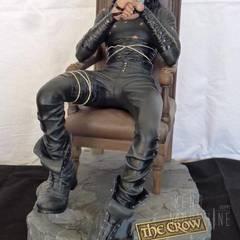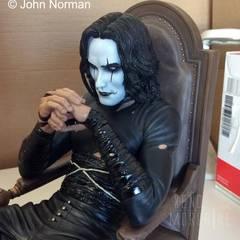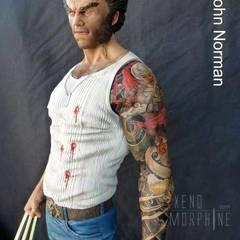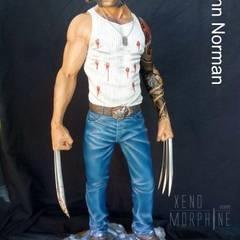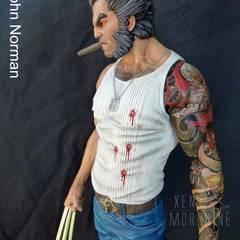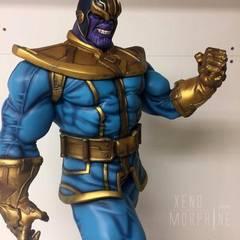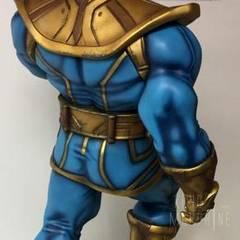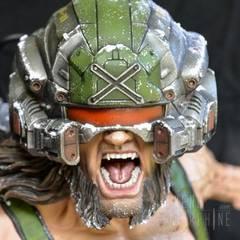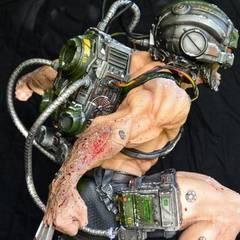Name: John Norman
Current Homebase: Queensland, Australia
Infected since: 1990
Fields of Action: Build up & Paint, Repaint, Environment Modeling
8 Questions to John Norman (Oct. 2019)
1. Let's go back in time. What lead you to start building up and painting model kits?
I’ve been an painting enthusiast for most of my life now. I think I started to paint Warhammer miniatures back in 1990. But what lead me into painting resin kits was actually by accident: About six years ago I bought my very first statue online with local pickup and when I showed up there, I was totally blown away by the seller´s collection. He was polite enough to show me some model kits which still needed to get build up and painted. I was even more surprised, when he mentioned that there was no one in Australia doing this kind of work, so he had to get finished all his kits overseas. But in the end it actually was my partner and future wife who brought up that I had a faible for painting figures and so this collector immediately asked me if I wanted to finish a kit for him. Building up and Painting that kit, a model of a facehugger, was like an initial ignition - and from that moment on I never have looked back. On the contrary, I since have fallen deeper and deeper into the rabbit hole.
2. What are your sources of inspiration - then and now?
My sources of inspiration vary. First, I always get inspired by the works of fellow artists, trying to learn and adapt interesting techniques, studying their results or if possible getting in touch with them to exchange processes and methods. Second, movies are also very inspiring to me, as many kits are based on popular culture franchises. Last but not least my clients are a true creative source: Before starting a fresh kit, I usually brainstorm with them about the basic direction they want to go, e.g. color schemes etc. Interpreting their vision is very important to me, but on top of that I always try to push boundaries by adding my own spins.
3. Tell us about your creative process when you receive a new model kit as a commission!
For me a creative process is all about getting into a good dialogue with my client from start to finish. I continuously keep working with them by showing them steps of progression, demanding some thought-given feedback or by suggesting new color applications to contrast or highlight certain details. I set high standards for myself, so the steps of progression are regularly alternated by just looking at the kit precisely from different angles, focusing on all it´s sculpted details if they are getting the treatment they are meant for. These moments of reflecting the own work surely can take some time, but they are an important part of the process. Sometimes a model kit even encourages me to take it up some levels to make it more unique or just to improve it. So - a positive provided from my client - I often costumize a kit by adding some details here and there on the sculpt, it might happen that I even destroy some parts of the original sculpt, e.g. to give it a more battle damaged look, or - like I did with NARIN´s Aboriginal Predator - designing a complete new base to create a more fitting overall picture. Furthermore, music is a constant companion while I’m working on a kit. It helps me to keep the flow of painting as some steps can get quite repetitive, e.g. painting nearly 200 dreadlocks recently. Not to forget, a good working environment is essential for a fluent creative process. I set up a full workshop in my garage, so I can do nearly all of the working steps from assembling to painting in one place. I consider myself lucly that I do not depend on a certain daytime, some people are only nightworkers, I can work any time. With a little offspring around now, this really helps to get back on the bench whenever there is a slot for it.
4. How did you learn your techniques to build up and paint?
Basically, a deep and thorough research always has been and always will be a solid foundation of my self-educated skill development. Currently I am working on a project that is way out of my scope (for now), therefore an extensive research is indispensable. Beyond that, as I mentioned before, I started in my very early days in the fields of miniature painting. So I can honestly say there is quite a history in gaining experience in this hobby. I never really paused, and as the years went by I kept searching for new challenges to upgrade my skills, e.g. I changed to bigger scales with way more detailed sculpts and, subsequently, trying to push myself by choosing projects with higher degrees of difficulty. But: Improving skills is never a linear process! I love to experiment, and as you know the ground formula for experimenting is simply "try and error". As long as you are considering yourself as an artist, you never get sated of learning - and for myself I can say: I am very hungry.
5. What is your most cherished item in your own collection? Why? What´s the story behind it?
My most cherished item is a very worn and damaged Wolf Predator Legendary Scale Statue by Sideshow Collectibles. It is an original, superbly sculpted and dynamic masterpiece I have loved from the moment I have seen it for the first time. But at the time this gem was out for preorder, it just had been out of my price range, and due to it´s very limited run of only 200 pieces made worldwide, it went out of stock fast and has since become one of the most wanted trophies by countless collectors worldwide. Actually no need to mention, that with this unbroken high demand the Wolf´s value increased way up from it´s original price on the secondary market - if it ocurred there frome time to time at all. But one day luck was on my side and I got the chance to trade one of these statues by offering my painting services and some amount of cash on top. So I can proudly say, I did fullfill my collector´s dream and do own one of the true and rare grails in the scene now. From here I will eventually restore it to all its glory by giving it the Norman treatment.
6. In your opinion, where is the scene heading into 10 years from now on? Will you still be part of it?
I think the scene will always have a following.I try to make it clear with only one popular franchise (and there are tons of it), that I consider myself a die-hard fan of: just look how long the ALIEN (1979) and PREDATOR (1987) universes exists and are still and constantly beeing explored, expanded, crossed over with each other or even moxed up with completely other universes in the most different ways of media. Consequently, collecting rare and original stuff from these franchises will always play there important role, too. And still it is uniting fellow enthusiasts new and old from around the world (I love this fact!). To answer the second part of your question: I would absolutely still want to be around as long as the scene will have me.
7. What are you currently working on, and what are your future plans or projects?
I just finished some quarter scale Predator busts: the Wolf Predator by Sab Paphawin (SAB from Thailand), the Skull Hunter and Death Mask, both sculpted by Claman Narin (NARIN Studio, also from Thailand). Currenly I am working on a bunch of little repairs and, to satisfy my needs for variety, a couple of repaints of statues from the MARVEL universe are on the bench also. A Terminator 2 bust is waiting next in line and my future projects to start the year 2020 will be some more NARIN Kits, classic one´s and new one´s.
8. Is there some thought left you want to share with us?
In a sentence short: always pursue your passion in life.
Interested in getting in contact with John? Drop him a message!
Email: John Norman
Facebook: John Norman

